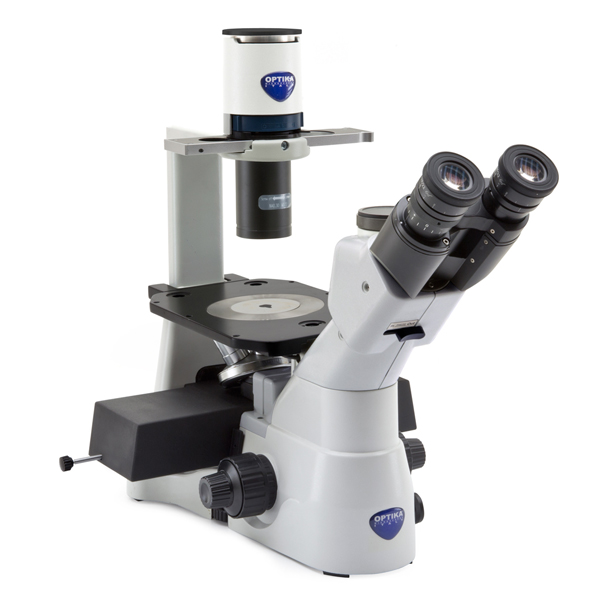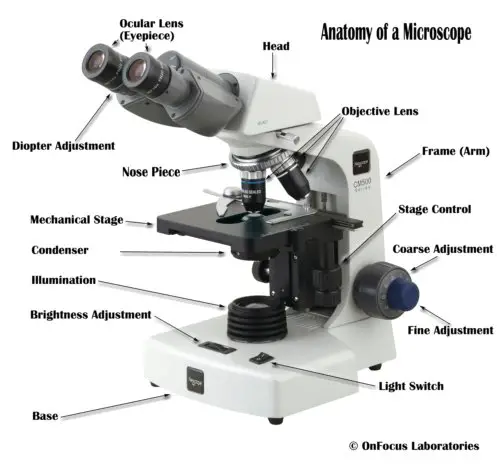Match These Characteristics to the Appropriate Type of Microscope
Here are five types of microscope their specific qualities and uses. A microscope that has lower magnifying power but can provide 3-dimensional viewing of objects.
Light - uses visible light can be used with living cells affordable requires thin samples.
. It has high magnification. The magnification of a compound microscope is most commonly 40x 100x 400x. This type of microscope called a SAM is used to find cracks and voids detect.
You can view individual cells even living ones. Stage This is the section in which the specimen is placed for viewing. They have stage clips that hold the specimen slides in place.
A separate set of lenses is used to focus the light into the eye or camera to form an image. Compound microscopes are light illuminated. Match the description to the part on the diagram.
Match these characteristics to the appropriate type of microscope. A uses a laser to view a single plane of a specimen. Large knob that moves the stage up and down to focus the sample.
C light passes directly through specimen. Lens at the top of the microscope that the user looks through. A dissection microscope is light illuminated.
This lens most commonly magnifies a sample by 10x. Read about each microscope part. The compound microscope can be used to view a variety of samples some of which include.
The microscopes have varied applications and modifications that contribute to their usefulness. PMT sCMOS Image Formation. D detects electrons deflected from the surface of the specimen.
On the other hand the dissecting microscope has a low magnification power of up to 70x. Check whether the lens being used is appropriate. Platform where a slide is placed.
Scanning Acoustic Microscope - These use a principle similar to sonar in that they employ sound waves to measure the sample. These microscopes collect the light from the sample with the help of multiple lenses. These include dark field microscopes and phase contrast microscopes which operate by scattering light in order to capture specific parts of the specimen like a single cell.
The arm connects the body tube to. There are more than two lenses in a compound microscope. A microscope which magnifies from magnification ranging from 20X to approximately 30000X and provides a 3-dimensional view of the specimen.
Electron - uses beam of electrons preparation kills living cells expensive can observe details on opaque samples Identify which type of microscope light or electron would be most appropriate to observe each sample. Compound microscopes are used to view samples that can not be seen with the naked eye. A microscope that allows easy observation of 3D objects at low magnification.
These microscopes are heavier and larger than simple microscopes. Compound microscope is a type of optical microscope that is used for obtaining a high-resolution image. Learn about the working principle parts and uses of a compound microscope along with a labeled diagram here.
A typical microscope that uses transmitted light to observe targets at high magnification. These are quality-assurance devices designed to test an examiners competence or the competence of a laboratory system not the validity of a theory or technique. However it has a low resolution.
For microscope observation you need to know if the lens characteristics match the observation purpose. The body tube connects the eyepiece to the objective lenses. The image seen with this type of microscope is two dimensional.
Unlike an electron microscope these scan in normal air rather than a vacuum or partial vacuum. Microscopeoptical technique that uses each type of detector 4. Useful as a means to change focus on one eyepiece so as to correct for any difference in vision between your two eyes.
A scope built of two systems of lenses for greater magnification an objective and an ocular. E shows specific molecules. Match these scientists with the statement regarding microscopy 6.
The lens closest to the eye is called the ocular while the lens. When used for validity and error-rate purposes these tests have many drawbacks. The second type of black-box test is a proficiency test.
This microscope is the most commonly used. The most common examples of this type of device are the handheld lens and eyepiece lens. A simple microscope is simply a large magnifying glass with a shorter focal length that has a convex mirror with a small focal area.
Digital microscopy Meanwhile digital microscopy operated by utilizing light microscopy principles and techniques then converting the resulting analog image into a digital version that can be viewed. A microscope that uses different light transmission characteristics of materials such as crystalline structures to produce an image. B detects electrons passing through a specimen.
Some of the basic types are discussed below. Match the following microscope techniques to the appropriate optical basis 5. Loose tissue Reticular tissue Both Contains ground substance Variable appearance under microscope - may be mesh - like or more like dense connective tissue Regular mesh - like appearance under microscope Contains ground substance Has elastic ²ber s Has ²broblasts Has reticular ²ber s Has ²broblasts Has reticular ²ber s Has elastic ²ber s Regular mesh - like.
The common light microscope used in the laboratory is called a compound microscope because it contains two types of lenses that function to magnify an object. Technique Optical Basis. The numerical aperture NA is important especially for fluorescent observation.
But the scanning can be slow and the maximum image size is limited. A compound microscope has multiple objective lenses and one eyepiece while a dissecting microscope has a single objective lens and two eyepiece lenses. Blood cells cheek cells parasites bacteria algae tissue and thin sections of organs.
There are two types of adjustment knobs ie fine adjustment knobs and coarse adjustment knobs. There are different types of compound microscopes. The Adjustment knobs These are knobs that are used to focus the microscope.
The lens the viewer looks through to see the specimen. The eyepiece usually contains a 10X or 15X power lens. A compound microscope has high magnification power up to 1000X.
5 Optical Mineralogy Mineralogy

Mastering Microbiology Ch 3 Flashcards Quizlet
5 Optical Mineralogy Mineralogy

Introduction To The Microscope Ppt Video Online Download
5 Optical Mineralogy Mineralogy

Science Tools Worksheets Science Tools Learning Science Interactive Science Notebook

Stereomicroscope An Overview Sciencedirect Topics



Comments
Post a Comment